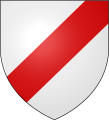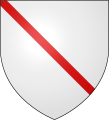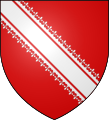Talk:Bend (heraldry)
| This article is rated Start-class on Wikipedia's content assessment scale. It is of interest to the following WikiProjects: | ||||||||
| ||||||||
Fair use image
[edit]The image of the bend is licensed as fair use to illustrate the object in question. It should not be used to illustrate the ordinary.--dave-- 21:20, 7 November 2006 (UTC)
Bend double dancetty
[edit]Should be mentioned in this article despite its not being a type of bend. --Daniel C. Boyer 16:51, 14 December 2006 (UTC)
- Sure. 98.27.163.42 (talk) 20:19, 25 August 2008 (UTC)
- What is it? I haven't found much evidence of the term. Does it belong in Line (heraldry)? —Tamfang (talk) 00:39, 25 May 2023 (UTC)
What does it mean to have...
[edit]A bend or in the dexter base? 98.27.163.42 (talk) 20:20, 25 August 2008 (UTC)
- Seems anomalous. I suspect there's more to the blazon than that; can you tell us more? —Tamfang (talk) 05:43, 13 September 2008 (UTC)
- Likely the blazon is something like Gules a bend or in dexter base a teapot argent: what's in dexter base is not the bend but the accompanying charge. —Tamfang (talk) 06:24, 2 May 2018 (UTC)
external
[edit]I'm going to delete all three of the inline external links, for different reasons. The White Lion Society has apparently reorganized its Armorial, so our link there is broken. The other two links are to pages containing numerous shields, and I consider it not helpful to tell the reader "it's in there somewhere, you find it." —Tamfang (talk) 05:00, 17 February 2010 (UTC)
Geekdiva's questions
[edit]Next time ask on the Talk page, that's what it's for.
- Does it have to be several items? Can one long item be in bend?
One does sometimes find a spear in bend but bendwise is preferred to avoid ambiguity.
- In French blazon, if memory serves, multiple items are rangé(e)s en bande and a single item is posé(e) en bande. —Tamfang (talk) 19:19, 11 December 2013 (UTC)
- In the preview, the citation numbers referring to outside sites are not superscripted, do not appear in the Notes section, and are out of sequence with the superscripted numbers. This actually may be Wikipedia style that I am not familiar with, but I am not able to research it right now. Thanks, Geekdiva
I don't know whether anyone intended it that way, but that's the normal result of mixing footnotes with direct external links. —Tamfang (talk) 05:05, 17 February 2010 (UTC)
Disagreement with Abatement (heraldry) page
[edit]After trying to find some information on abatements, it seems that this article directly contradicts that of the Abatement section in regards to bend sinister.
In this article it is said to denote illegitimacy. In the Abatement article it is listed as a common misconception that bend sinister denotes illegitimacy. Which is correct? - 58.166.89.162 (talk) 13:00, 11 December 2013 (UTC)
- The source that was used on the abatements page (http://www.internationalheraldry.com/), is evidently a self-published website and therefore not too reliable. I've added some better sources to this article, including Charles Boutell's The Handbook to English Heraldry (1914, p. 191), which says that the bend sinister was one of the symbols used in England to identify illegitimate offspring of royalty. —Sangdeboeuf (talk) 02:20, 29 May 2017 (UTC)
ISO No symbol as a modern mark of distinction
[edit]The bend sinister (commonly but incorrectly called "bar sinister" outside heraldic usage) occasionally functioned as a mark of distinction, modifying the meaning of whatever coat of arms it was added to in a standard recognizable way, in particular indicating bastardy. The modern ISO No symbol, as in No Smoking and No Parking, is graphically similar; but more importantly performs a similar function, in this case indicating that whatever it added to is prohibited. Though this similarity does not justify calling the No symbol a "bar sinister", barring a reliable citation of such usage, I believe it is consistent with the policy and spirit of Wikipedia to briefly mention the semantic and graphic similarity between heraldic and modern symbols, despite their independent origin. They may be viewed as an example of convergent evolution in graphical communication, where a similar need---to efficiently convey a particular modification of meaning---gave rise to similar solutions.CharlesHBennett (talk) 14:14, 17 January 2017 (UTC)
- Actually, the "policy and spirit of Wikipedia" forbids novel interpretations and theories by Wikpedia contributors; see Wikipedia:Five pillars. —Sangdeboeuf (talk) 22:03, 22 May 2017 (UTC)
Bend sinister for illegitimacy
[edit]Several sources cited in the article state that a bend sinister (or a diminuitive form) was often or occasionally used as a mark of illegitimacy in aristocratic coats of arms. See e.g. Fox-Davies (1909, p. 512); Woodward (1896, p. 172); Boutell & Fox-Davies (1914, p. 191); and O'Shea (1986, p.12). The recent edit replacing bend with baton does not match the source cited (Bertelli & Litchfield 2003, p.174). Perhaps the user who made the edit is confusing bend sinister with bar sinister. In any event, changes such as these need to be supported by reliable sources, so I have restored the original wording. —Sangdeboeuf (talk) 23:57, 12 July 2017 (UTC)
External links modified
[edit]Hello fellow Wikipedians,
I have just modified one external link on Bend (heraldry). Please take a moment to review my edit. If you have any questions, or need the bot to ignore the links, or the page altogether, please visit this simple FaQ for additional information. I made the following changes:
- Added archive https://web.archive.org/web/20091116220334/http://www.theheraldrysociety.com/resources/members.htm to http://www.theheraldrysociety.com/resources/members.htm
When you have finished reviewing my changes, you may follow the instructions on the template below to fix any issues with the URLs.
This message was posted before February 2018. After February 2018, "External links modified" talk page sections are no longer generated or monitored by InternetArchiveBot. No special action is required regarding these talk page notices, other than regular verification using the archive tool instructions below. Editors have permission to delete these "External links modified" talk page sections if they want to de-clutter talk pages, but see the RfC before doing mass systematic removals. This message is updated dynamically through the template {{source check}} (last update: 5 June 2024).
- If you have discovered URLs which were erroneously considered dead by the bot, you can report them with this tool.
- If you found an error with any archives or the URLs themselves, you can fix them with this tool.
Cheers.—InternetArchiveBot (Report bug) 23:55, 17 July 2017 (UTC)
Image gallery
[edit]Gallery
|
|---|
|
I've removed this from the article. The different images don't really add to an understanding of the specific topic; instead they seem to be more or less indiscriminate examples of other kinds of heraldry jargon. —Sangdeboeuf (talk) 11:36, 7 June 2018 (UTC)











